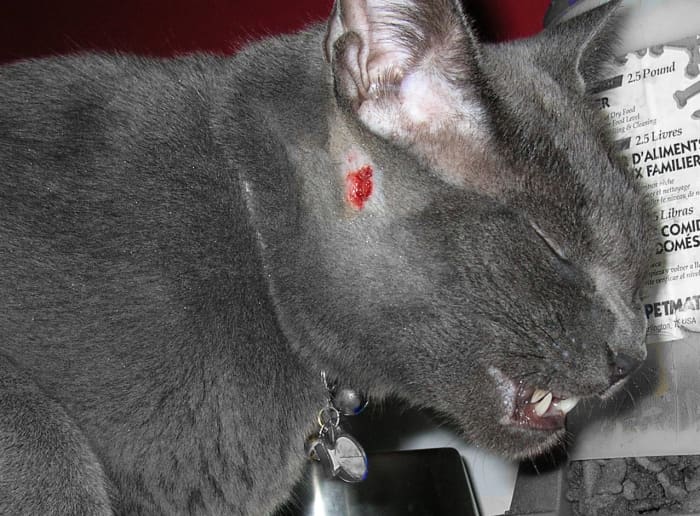Why Do Pet Cats Attack Their Owners?
My Cat Attacks Me Unprovoked!
Cats are one of the most popular pets in the world and are savagely beloved by millions, although the dangers present from their razor-sharp claws and teeth, such as serious infection, are largely not taken seriously. But how much of a threat do they really pose to human health? Have domesticated cats ever killed a person?
In this article, you'll learn...
- Can cats cause human fatalities or severe injury?
- Overlooked dangers of pet and feral cats
- Why might a cat become aggressive?
- A list of reported cat attacks and aggression (plus video)
Human Fatalities
Cats are too small to kill a human by force with the exception of human babies, although there are no reported cat-related deaths involving infants in recent U.S. history. Domesticated cats are also the subjects of various folklore, including the old wives' tale that they can suck the breath from an infant, which might lead some people to believe that they are dangerous with small children.
However, cats typically have little incentive to attack a helpless child. They are predators of small animals like mice and birds, and have territorial tendencies directed towards competing animals and predators, therefore babies are relatively safe. The recipients of reported cat attacks have largely been adults, although aggression toward infants has occurred. You won't find statistics about cat bite incidences like you will of dogs and exotic pets, because people don't really care.
Are All Cats Dangerous?
It is important for anyone who wants to understand animals and their behavior to place things in the proper perspective. Cats are domesticated, but this term is useless when discussing the propensity of aggression, whether or not a pet is capable of attacking, and basically anything else meaningful.
The fact that cats are domesticated and widely kept as pets often misleads people into thinking they do not have the instincts associated with so-called wild animals. All cats are products of their environment, and if a cat is not socialized with humans, it will become just as 'wild' as what they've descended from (and, vice versa, many wild cats can be tamed when human-socialized, although to different extents).

Humans and dogs are not the only victims of cat aggression
woodleywonderworks (CC BY 2.0) Via Flickr
Why Do Cats Randomly Attack?
Most domesticated cats (and dogs), when socialized, will never severely bite or attack humans as long as they aren’t "provoked." However, this comforting fact does not determine whether or not your pet might end up unexpectedly acting aggressively one day as animals, not being robots, are subject to the same shifts in mood that result from various factors that may be hormonal, stress-related, or a response to an environmental change.
It is all too common for pet owners to say "he's never done this before" when they experience a bite from their pet. At any point, in any situation, there can be a first time for anything.
It is often the case that people view animals like tigers and jaguars as dangerous because they are "wild." It is very important to consider that domestication has little to do with why a cat has never killed a person. Size is by far the most important factor that causes such incidences. If domesticated cats had the same size and musculature as lions and tigers, they would be extremely dangerous pets. This, and only this is what makes tigers dangerous—most tame big cats won't attack their owners for most of their life, but there are those one or two fatal 'exceptions' that can occur at any time.
So, repeat the following mantra if you really want to understand animals: domesticated is meaningless, domestication is meaningless.
How Common Are Cat Attacks?
While most people find it shocking and amusing when a surprisingly severe cat attack is caught on video, such incidences probably occur more often than people realize. This is how domesticated pets can end up being more of a threat to the public because people don't expect it from them. Dogs and cats do emit behavioral signs of impending aggression that are often missed or not taken seriously by their caretakers. Aggression is indeed common but not as common as aggression that results in severe injury.
Cause of Cat Aggression and Attacks
- Redirected Aggression: Lashes out at owner after sensing something it can't access. May seem like it occurs for no reason because the source of agitation isn't present.
- Petting-induced Aggression: When petting causes overstimulation or discomfort, cats may bite their owners (signs of agitation include tail swatting, skin twitching, meowing, or changing body position).
- Fear: The root of most cat aggression.
- Territorial: Natural aggression all cats are prone to and can occur with other cats, animals, and humans.
- Maternal Aggression: The insecurity of a female cat with kittens.
- Pain-induced: Retaliation if an owner touches the cat in a painful area.
- Unprovoked Aggression: When a cat is aggressive for seemingly no reason. Rare, and hard to diagnose. Often mistaken for redirected aggression.

Many pet owners fail to become attuned with their pets' mannerisms which may hint that an animal is becoming irritated.
Andy McLemore (CC BY-SA 2.0) Via Flickr
Signs of Cat Aggression
Many pet owners fail to become attuned with their pets' mannerisms which may hint that an animal is becoming irritated. Here is a list of the more subtle signs of aggression and agitation in domesticated cats.
Defensive (submissive) posture:
- Ears pointed back, flattened
- Dilated pupils
- Piloerection (fur stands up)
- Tail curved and tucked inward
- Crouching
- Turning sideways to an opponent, not looking straight on
- Open mouth, hissing, and spitting

This cat is defensive because of the downward, curved, bristled tail (raised and bristled also is fearful), flattened ears, gaping mouth, and stiff legged posture. Sometimes the postures of defensive and offensive can resemble each other.
Offensive Aggression (LOOK OUT)
A posture that indicates offensive aggression may result in an attack. Never attempt to console or calm a cat that is showing these signs:
- Faces the opponent (instead of slinking or leaning in the opposite direction)
- Direct stare, steps forward
- Tail points straight down (as opposed to curved downward)
- Ears are pointed upright with the back rotated slightly forward
- Piloerection (fur stands up)
- Growling
*Some of these signs are present in defensive aggression. The most obvious distinguishable signs include the ears, vocalizations, and movement of the cat (is it backing away or inching forward?)
*Rabies, a lethal disease in cats, can result in irrational behavior. Such animals suspected of showing symptoms should be euthanized immediately.
Take Cat Bites Seriously
Cat attacks are no laughing matter, and aside from the frequently reported agony that they cause to the victims, cat bites are heavily prone to infection, even more so than dog bites. The reason this is so is due to the sharpness of cat teeth creating deep puncture wounds into areas that are sufficient for bacterial activity and hard to clean.
A study determined that 1/3 of patients who sought treatment for cat bites in a three-year period had to be hospitalized, and 2/3 of these patients ended up needing surgery to flush out the bacteria via debridement. If a cat bite occurs over a joint or tendon along with swelling, redness, and pain, this increases the chances that a hospital visit might be needed.
Bites by unfamiliar cats with access to the outdoors are a substantial rabies risk. While cases of humans contracting rabies are rare, cats are the pet most frequently found with the virus in the United States.
- Cat bites to the hand can cause serious infections, Mayo study finds | MinnPost
Cat bites should be taken seriously, for they can lead to difficult-to-treat bacterial infections — in fact, much more so than dog bites — according to a new study by researchers at the Mayo Clinic.




